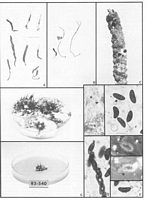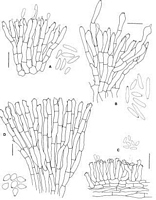|
 Xylaria hypoxylon Xylaria hypoxylon
SynonymsClavaria hypoxylon
BiostatusPresent in region - Indigenous. Non endemic
Images (click to enlarge)
Caption: Fig. 14 Xylaria hypoxylon A, Stromata (PDD 45372). B, Anamorph stromata (PDD
45372). C, Stromal surface (PDD 45372). D, Ascal ring (Melzer's reagent, PDD 45361). E,
Ascal ring and ascospores (Melzer's reagent, PDD 45371). F, Ascospores (Melzer' | 
Caption: Fig. 20 Xylaria anamorphs A, X. hypoxylon (PDD 45372 from nature). B, X. cf. berkeleyi
(PDD 44421 from culture). C, X. cf. filiformis (PDD 44321 from nature). D, X. theissenii
var. macro |
Description: Stromata: Stromata upright (taller than broad), or filiform; stipitate; apex pointed and sterile; 15-20 mm tall; 1-2 mm diam.; perithecia inconspicuous, or conspicuous, or about 1/3 exposed; ostioles lower than or more or less equal to stromatal surface; stromatal surface wrinkled; dark brown (brown vinaceous), or blackish; KOH-extractable pigments lacking; tissue below perithecia conspicuous, essentially homogeneous, white.
Perithecia: Perithecia more or less globose.
Asci: Stipe long with spores more or less confined to upper half of ascus; amyloid ring higher than broad.
Ascospores: Ascospores 11.5-13.5 µm long; 4.5-6 µm wide; brown; 0-septate; in side view inequilateral, flattened on one side, curved; in face view oblong-elliptic; ends broadly rounded. Germ slit straight, spore-length, or straight, less than spore-length; on flattened side of spore. Perispore indehiscent in 10% KOH.
Article: Rogers, J.D.; Samuels, G.J. (1987) [1986]. Ascomycetes of New Zealand 8. Xylaria. New Zealand Journal of Botany 24(4): 615-650 (http://www.rsnz.org/publish/abstracts.php).
Description: Stromata solitary or gregarious, unbranched, 1.5-2.0(-3.0) µm long, at first conidiogenous
and white: perithecia intercalary and formed in 1 or 2 cylindrical clusters or, less
frequently, forming over the entire length of the axis except on the acute apex, fertile
portion 2 mm diam., perithecia completely immersed or nearly superficial; surface of the
fertile portion somewhat tuberculate, with longitudinal splitting; brown tissue sometimes
evident: perithecia) openings umbilicate to slightly papillate or not evident. Internal tissue
white, solid. Stipe and axis sharply delimited from fertile portion, wiry, < 0.5 mm diam.,
black and glabrous or with fine tomentum of brown hyphae. Asci 170-200(-225) µm total
length x (5.0-)5.5-7.0(-8.0) µm, sporiferous part (65-)72-95(-120) µm, cylindrical; apical
ring J+, wedge-shaped, 2.0-2.5 µm wide x 2.0-4.5 µm high; 8-spored, ascospores uniseriate
with overlapping ends. Ascospores (10.0-)11.5-13.5(-15.5) x 4.5-6.0(-6.5) µm,
inequilateral with one side flat to concave and the other side rounded; elliptic in top view;
transparent brown; slit slightly less than full length to full length, parallel to the long axis
of the spore. Conidiophores in vivo forming in a white layer along the length of the
filiform, < 0.5 mm diam., stromatal axis. Conidiophores forming a dense palisade;
conidiogenous loci terminal with a 1 µm diam. refractive frill remaining after conidial
dehiscence. Conidia (6.0-)7.2-10.7(-11.5) x 2-3 µm, narrowly elliptic to clavate, colourless,
smooth: each with a 0.5 µm wide, flat, refractive basal abscission scar.
CHARACTERISTICS IN CULTURE: Colonies grown 3 weeks at 20°C diffuse daylight
on OA 3-4 cm diam., flat or with conspicuously barraging hyphal ropes or young stromata
around the depressed centre and with blackening in the centre of the colony; acute, 7 mm
long stromata arising from the centre of the colony; stromata black below and white above,
sterile.
Habitat: HABITAT: Decorticated wood, most often in running water.
Distribution: DISTRIBUTION: NORTH ISLAND: Coromandel, Gisborne. SOUTH ISLAND: Buller,
Westland, Southland,
Notes: Xylaria hypoxylon is a complex species which will probably eventually be shown
to include several taxa. It has been reported from almost every part of the world but seems
most common in temperate regions. It is apparently not common in New Zealand, where it
is most often found on blackened wood in running water.
Xylaria hypoxylon sometimes superficially resembles X. cf. filiformis in its wiry axis, but
the former species is usually much more robust than the latter. They are separable on
ascospore characters. Moreover, X. hypoxylon occurs on wood, whereas X. cf. filiformis
occurs on herbaceous debris and leaves.
Xylaria hypoxylon has been cultured many times by various persons. Our New Zealand
cultures greatly resemble those of Callan (1985) initiated from stromata collected in the
western United States. Her cultures particularly resembled ours in production of sterile
stromata. Conidia from naturally produced stromata were slightly larger than those reported
herein (Callan 1985).
|